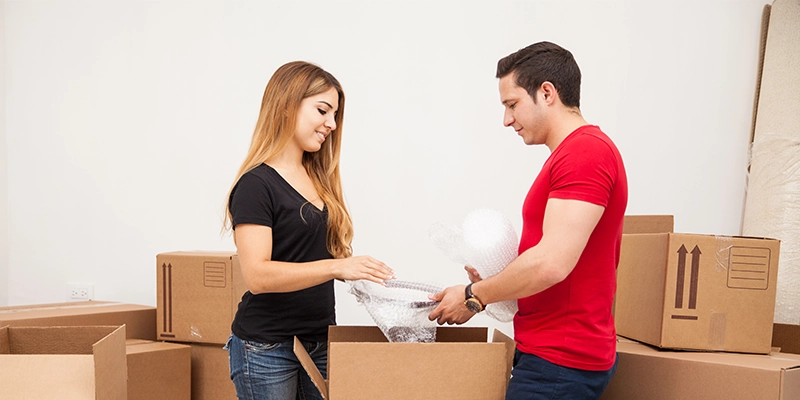The Complete Guide on Packing with Bubble Wrap
Unlock the potential of bubble wrap with our expert guide. From securing your electronics to protecting plants and smart recycling tips, we've got you covered. Step into a world of practical and eco-friendly bubble wrap uses now!
17 min read
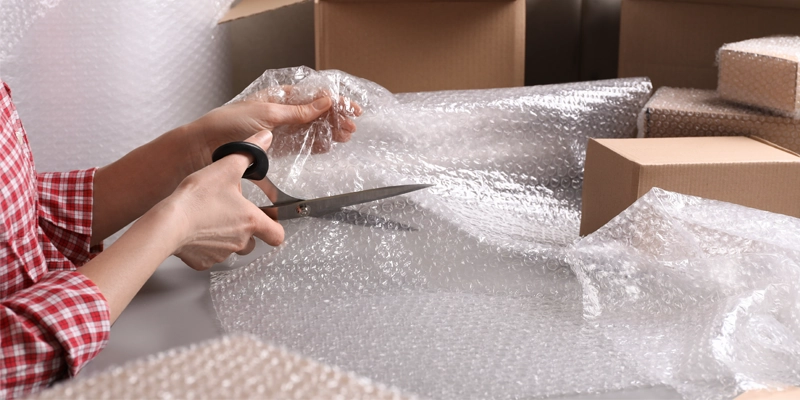
Key takeaways
- Use bubble wrap: anti-static bubble wrap and bags to safeguard sensitive electronics from both physical and static damage during packing and transit.
- Choose the right size bubble wrap and roll size: This is super important if you want to keep your stuff safe during the move.
- Secure the bubble wrap: By firmly wrapping it and using it as a filler for extra space in the box, you will prevent movement and potential damage.
- Use bubble wrap creatively: For gardening to protect your plants from frost and facilitate safer relocation. You can even use it as a tool for innovative crafting activities, like creating unique paint prints.
- Always reuse bubble wrap: For your future move or a friend that needs to move. You can even reuse bubble wrap for temporary window insulation and protect delicate items on shelves or in drawers.
- Recycle bubble wrap: By recycling bubble wrap responsibly, following local guidelines and utilising specialised drop-off points for soft plastics. You can support the creation of recycled plastic products and reduce landfill waste.
Allow me to set the scene: you're standing amidst a sea of cardboard boxes, your prized possessions waiting to be packed securely for the big move. But wait! Before you launch into a packing frenzy, allow me to introduce you to the MVP of moving day, the unsung hero packing material with the intended purpose of protecting your belongings throughout the moving journey: Bubble wrap.
Yes, bubble wrap! That exhilarating, bubble-popping, stress-alleviating phenomenon has managed to bring joy and safety in equal measures. You might be thinking, "Calm down, it's just packing material," but oh, it's so much more than that! It's an adventure waiting to unfold, a story in each bubble, a marvel of packaging innovation that stands between your beloved belongings and the perils of the moving journey.
In this complete guide, we're not just brushing the surface; we're plunging headfirst into the bubbly world of bubble wrap. We'll explore bubble wrap in all its forms, mastering its use to ensure every item finds its safe haven.
From answering the age-old questions of "What are the standard bubble sizes?" to the more baffling question of "Is bubble wrap supposed to face in or out?" Get ready to transform your moving experience, one bubble at a time!
Why use bubble wrap?
When it comes to keeping your precious items safe during transit, there's nothing quite like bubble wrap. It's like a modern packaging superhero! Bubble wrap is this lightweight and versatile plastic sheet with those fun air-filled bubbles on one side. It fits snugly around your precious stuff, giving them multiple layers of protection. It's reliable, stress-relieving, and just makes the whole moving process a little less nerve-wracking.
Think of bubble wrap as the ultimate bodyguard for your stuff! Whether you're packing a delicate ceramic vase, your favourite piece of furniture, or an essential electronic device, bubble wrap has got your back. It's like your personal shield, protecting your precious items from any potential harm during the bumpy ride in the moving truck. Plus, it's so versatile! You can use it to keep your glass and plates from rubbing together or fill up empty space in a box. So bubble wrap correctly and it will be a lifesaver for keeping your belongings in tip-top condition.
How to use bubble wrap?
The correct way to use bubble wrap is with the bubble side facing towards the item you are wrapping. This provides maximum protection, as the bubbles create a cushion of air, absorbing any impacts or shocks during the move. The flat side of the bubble wrap is easier to secure with packaging tape, ensuring a snug fit around your valuable items. So remember, when packing with bubble wrap, bubbles go in!
Choosing the right type of bubble wrap
Choosing the right bubble wrap is super important to make sure your stuff stays safe during transit. There are different types of bubble wrap for different needs, so it's good to know what works best for your items. Just think about what you're packing and the differences between bubble wraps. That way, you can pick the perfect bubble wrap and give your things maximum protection on their journey.
Bubble wrap products
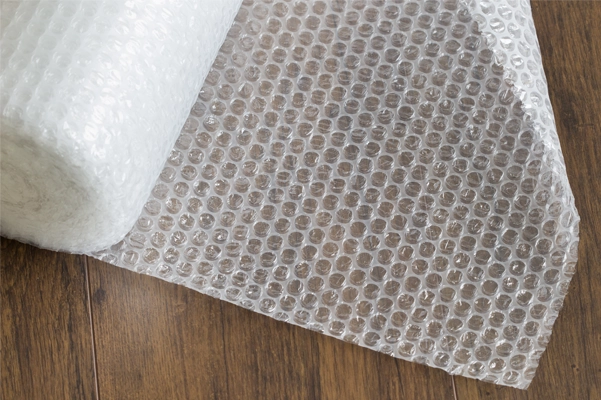 Standard bubble wrap
Standard bubble wrap
Standard bubble wrap is arguably the most widely recognised and utilised type of bubble wrap. Its closely packed air-filled bubbles serve to provide cushioning and protect goods from shocks and vibrations during transportation. It's an economical choice, and widely available, making it a staple in packaging and moving supplies.
When to use standard bubble wrap?
Normal bubble wrap is such a handy packing material, that it's suitable for wrapping many items. Use it when packaging items that are moderately fragile and of medium weight. It's particularly useful for items like glassware, ceramics, framed pictures, and home appliances. Plus, its protective nature also makes it ideal for filling empty spaces inside boxes to prevent items from shifting around in the moving truck. It's an excellent choice for domestic moves or short-distance commercial transportation where the risk of damage is relatively low. Remember, the key is to use enough bubble wrap to completely cover your item and give it a cushioning layer from all angles.
Anti-static bubble wrap
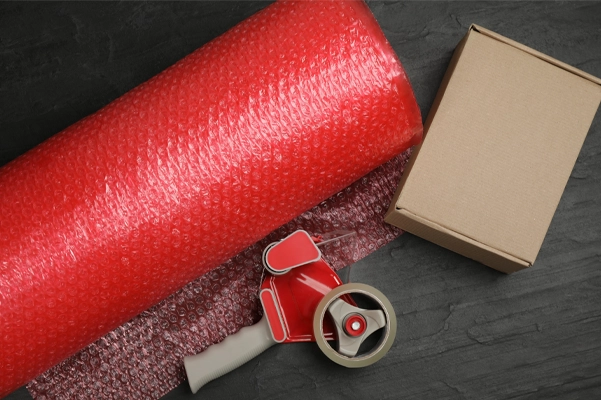 Anti-static bubble wrap is specifically designed for packing electronic devices and components. Unlike standard bubble wrap, it doesn't produce static electricity, its protective air-filled bubbles shield the wrapped item from physical damage, while the anti-static property safeguards the electronic components from any potential electrostatic discharge.
Anti-static bubble wrap is specifically designed for packing electronic devices and components. Unlike standard bubble wrap, it doesn't produce static electricity, its protective air-filled bubbles shield the wrapped item from physical damage, while the anti-static property safeguards the electronic components from any potential electrostatic discharge.
When to use anti-static bubble wrap?
When it comes to packing electronics and other sensitive devices, anti-static bubble wrap is your go-to option. Pack items such as circuit boards, computer components, and other electronic devices and other electronic gizmos that can get zapped by static electricity. Look out for that distinctive pink bubble wrap - it's how you identify it's anti-static bubble wrap!
 Bubble wrap bags
Bubble wrap bags
Bubble wrap bags, or bubble pouches as some call them, are ready-to-use bags made from bubble wrap material. They have this layer of protective bubbles that wrap around your stuff and keep them super safe inside.
When to use bubble wrap bags?
These bags are absolutely perfect for packing a variety of items like jewellery, small electronic devices, books, and trinkets. The best part? You don't even need to bother with cutting and taping because of their pre-formed pouch shape! Talk about making packing a breeze, right? Plus, they come with a self-seal lip for easy and secure closure. Now, they might not be the best fit for irregularly shaped or oversized items, but let me tell you, bubble wrap bags are insanely handy for protecting smaller, more standard-sized items. If you're all about both protection and efficiency, using bubble wrap bags is the way to go!
Recycled bubble wrap
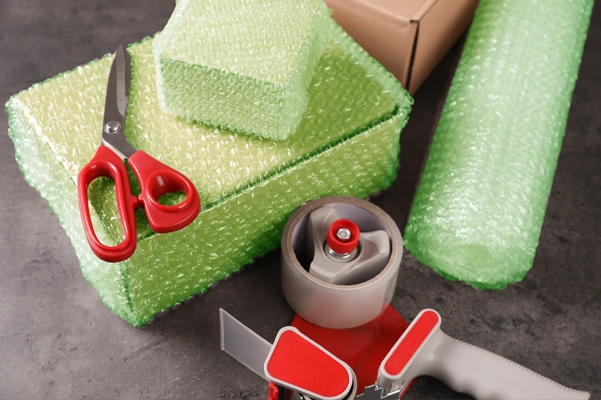 Did you know that recycled bubble wrap is actually made from recycled polyethylene? It's pretty cool because it still has the same protective properties as regular bubble wrap, but it's way more eco-friendly! 🌱 So, if you're looking for a greener option for your packing needs, recycled bubble wrap is the way to help the planet go a little greener.
Did you know that recycled bubble wrap is actually made from recycled polyethylene? It's pretty cool because it still has the same protective properties as regular bubble wrap, but it's way more eco-friendly! 🌱 So, if you're looking for a greener option for your packing needs, recycled bubble wrap is the way to help the planet go a little greener.
The production process involves using post-consumer waste, which helps reduce waste! Plus, the quality, bubble size and roll lengths are just as good as regular bubble wrap. It's like getting the best of both worlds - protection and sustainability. ♻️
But hey, it's important to keep in mind that even though it's a step in the right direction, recycled bubble wrap is still plastic. So, try to reuse it as much as possible before disposing of it.
Why choose the right bubble size and roll size?
Choosing the right bubble wrap roll size is super important to make sure your items stay safe during the moving journey. First off, using the right size means less waste and saves you money. Plus, using smaller bubbles for heavier stuff might not hold up, and bigger bubbles for delicate items won't give them the cozy protection they need. So, it's all about picking the perfect bubble size and a large enough roll size to cover whatever it is you are wrapping to ensure the best protection possible.
What are the standard bubble sizes?
Standard bubble wrap typically comes in 4 standard sizes. You will find that it is the height of the bubble that determines its size rather than its diameter.
| Bubble Wrap Type | Bubble Height (inches/mm) | Ideal Use |
| Mini | 1/8" or 3.18mm | Fine Jewellery, minature figurines |
| Small | 3/16" or 4.76mm | Slightly larger, yet still fragile, items such as glassware or ceramics. |
| Medium | 5/16" or 7.94mm | Electronics, kitchen appliances, and larger fragile items. |
| Large | 1/2" or 12.7mm | Large furniture, artwork, or heavy-duty appliances |
Mini bubble wrap
Mini bubble wrap is actually not that common, but it's absolutely perfect for wrapping super delicate items. You see, these tiny bubbles create this soft and cozy little carpet of protection, giving your most precious small items a gentle and loving hug.
Small bubble wrap
Small bubble wrap is typically around 10mm in diameter. It's tailor-made for packing smaller, delicate items that require a high degree of protection. The small bubbles provide a superior level of cushioning and shock absorption, making it ideal for wrapping items such as figurines, ornaments, glass elements, and ceramics—essentially anything that is petite in size but high in value.
Medium bubble wrap
Next up, we've got the medium bubble wrap. It's like the go-to choice when you need some extra padding for your game consoles, home entertainment systems, kitchen gadgets, and even those delicate vases. You know, the bigger stuff that needs a little more TLC.
Large bubble wrap
Finally, if you've got something big and bulky to protect and you need some serious cushioning and shock absorption, then the large-size bubble wrap is your go-to option. The large bubbles are way bigger, measuring 25mm in diameter. It's just what you need to keep your large furniture, artwork, or heavy-duty appliances safe and sound during interstate or long-distance moves.
What is the standard width of a roll of bubble wrap?
When it comes to retail rolls of bubble wrap, they usually come in widths of 375mm, 500mm, and 750mm. And guess what? They're conveniently perforated about every 300mm! So, you can easily tear off just the right amount you need, with no waste, and maximum efficiency guaranteed. Oh, and don't forget, you can buy bubble wrap rolls in roll lengths from 5 metres to a whopping 100 metres!
Packing items with bubble wrap
Wrapping fragile items step-by-step
Wrapping fragile items with bubble wrap requires careful attention to detail to ensure maximum protection. By following these simple step-by-step instructions to wrap fragile items you can prevent damage or breakage during transit.
- Start by laying your bubble wrap flat, with the bubble side up, on a clean and stable surface.
- Place the item to be wrapped in the centre, and gently fold the bubble wrap over it from all sides, ensuring that all areas of the item are covered.
- For extra fragile pieces, consider double wrapping for added security.
- Once bubble wrapped, secure with packing tape, ensuring that the tape doesn't make direct contact with the item to avoid potential damage when unpacking.
- Always remember to mark packages containing fragile items clearly to alert handlers to take extra care.
Tips on wrapping fragile items
- Choose the right bubble wrap: For a delicate item like a porcelain vase, using medium (5/16") bubble wrap would be the best choice. This size provides ample cushioning and shock absorption, making it perfect for protecting fragile items.
- Wrap in layers: Start by placing your vase in the centre of a sheet of bubble wrap. Bring the wrap over the item, ensuring that all parts are covered. Repeat this process with multiple layers until you have at least two to three layers covering every part of the vase. Remember, extra bubble wrap is better when it comes to protecting fragile items.
- Bubble side in: When you use bubble wrap, ensure that the bubble side is facing inward. The flat side is easier to tape and write on, while the bubble side provides direct cushioning to your item.
- Secure your wrap: After you've wrapped your item, take a roll of packing tape and secure the bubble wrap firmly in place. Make sure there are no loose ends that could catch on something and rip open. Also, tape down the ends of the bubble wrap to create a seal against dust and moisture.
- Packing multiple items: When packing multiple fragile items, never let them touch. Each item should be individually wrapped in bubble wrap and placed in the box with dividers or additional packing material (like packing peanuts) between them. This prevents collision and ensures ultimate protection.
Packing with bubble wrap as a separator
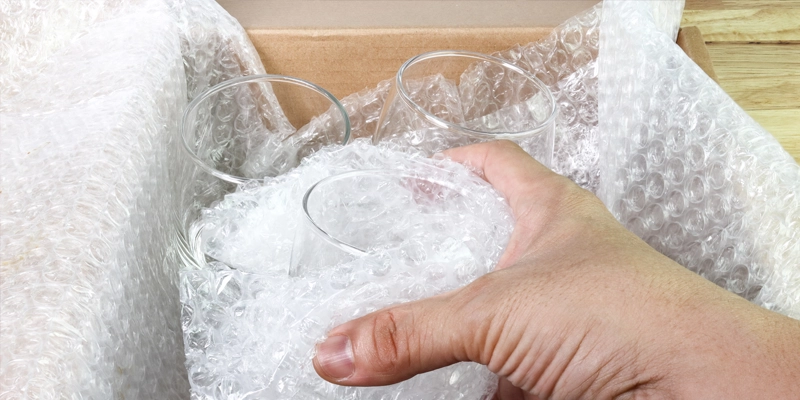
If you plan to pack with bubble wrap as a separator between stackable crockery and glassware before boxing you can:
- Start with laying a large sheet of packing paper on a table or flat surface.
- Cut a piece of bubble wrap that is large enough to use as a separator and place it on top of the packing paper in the centre.
- Then, place the first piece of stackable crockery or glassware on top of the bubble wrap.
- Cut another piece of bubble wrap and layer on top before repeating steps 2 and 3 over and over.
- Wrap the items with the packing paper
- Tape the paper with sellotape to ensure items are secure and you can now pack away into the moving box.
Remember, the goal is to immobilise your items in the box. They shouldn't move when you shake the box lightly. Following these tips will help you move your fragile items safely ensuring they arrive at their destination intact.
Protecting electronics with bubble wrap
Electronics can sometimes be quite valuable and need to be handled with care. This is because they have delicate components and fragile casings. That's where bubble wrap comes in! With its cushioning air-filled pockets, it's a great option for providing excellent protection.
Protecting mobile devices
When it comes to protecting your mobile devices like smartphones or tablets, using small (3/16") bubble wrap is a great choice. First, make sure to turn off your device and remove any accessories like cases. You can either put the device in a bubble wrap bag or completely wrap it in bubble wrap, making sure to cover all the parts including the screen and corners. To secure the bubble wrap, use packing tape, but be careful not to put the tape directly on the device.
Protecting laptops
For larger devices like laptops, medium (5/16") bubble wrap is often the best option. Before you start pulling out the bubble wrap and tape, ensure the laptop is turned off, and the charger is detached. Wrap the bubble wrap layer by layer, covering all sides and corners. Use packing tape to secure the wrap, ensuring that it is firmly in place without placing the tape directly on the device.
Protecting large electronics
To protect large electronics such as televisions or home theatre systems, large (1/2") bubble wrap comes in handy. The larger bubbles provide more cushioning for these typically heavier items. Before you start wrapping, make sure to unplug the device and remove any detachable parts. Carefully wrap the device, making sure all corners and sides are well-covered. Use packing tape to secure the wrapping, taking care not to place the tape directly on the device.
Just a friendly reminder, it's best to avoid using bubble wrap directly in contact with screens or other areas that could be affected by static electricity. Instead, opt for an anti-static bubble wrap or place a layer of anti-static material between your device and the bubble wrap. Better safe than sorry! 😊
Handy packing tips for electronics
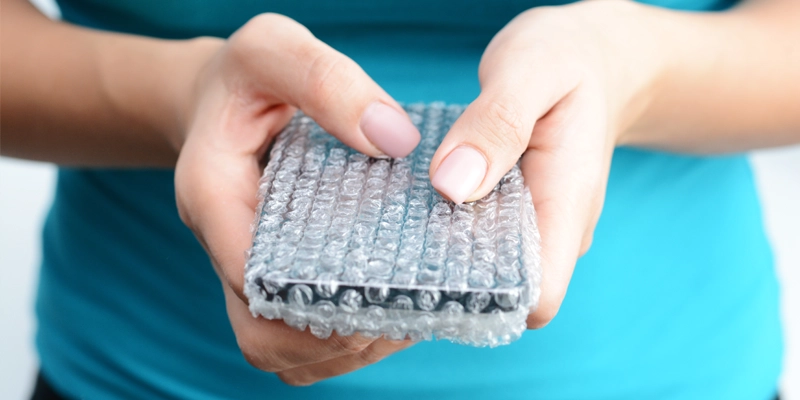
Packing electronic items can be a bit tricky because they're sensitive to static electricity. So, if you're moving stuff like TVs, computers, smartphones, tablets, or circuit boards, use anti-static bubble wrap! It prevents that pesky build-up of static electricity that can harm your precious electronics. Let's take a tablet device as an example:
- Choose the right bubble wrap: Tablet devices are sensitive to static so using anti-static bubble wrap is crucial. It not only provides physical protection but also prevents static damage. Anti-static bubble wrap often comes in a pink colour to distinguish it from regular bubble wrap.
- Use anti-static bags: Before wrapping your tablet device in anti-static bubble wrap, consider placing it in an anti-static bag. These bags are designed to prevent static build-up and act as an additional layer of protection for your device.
- Wrap thoroughly: To begin, position your tablet at the centre of the anti-static bubble wrap sheet. Ensure that the side with the bubbles is facing inward to offer optimal cushioning. Enclose the device with the wrap, making certain that all areas are adequately covered. Repeat this procedure until you have at least two to three layers enveloping every portion of the device.
- Secure your wrap: After you've wrapped your portable tablet, take a roll of packing tape and secure the bubble wrap firmly in place. Make sure there are no loose ends or bubbles that could potentially burst and cause damage.
- Packing inside the box: Place the wrapped device inside a sturdy box filled with similar items. If there's any extra space, fill it with anti-static packing peanuts or more anti-static bubble wrap. The goal is to prevent any movement during transit as this can lead to damages.
Remember, static electricity is a silent killer for electronics. Using anti-static bubble wrap and following these tips will help ensure your electronic items remain safe from both physical and static damage during their journey.
Creative uses of bubble wrap
Protecting plants
Did you know that bubble wrap can come to the rescue when it comes to moving plants, especially during those chilly winter months? It's true! See, plants in outdoor pots can be quite sensitive to frost damage. By wrapping the plant pots with some bubble wrap, you can provide insulation and safeguard the plant's precious roots from the harsh cold. And hey, it's not just for frost protection! If you've got some fancy plant pots made of clay, concrete, or wood, bubble wrap can lend a helping hand during the move. So, here's the lowdown on how to get it done:
- Choose the right bubble wrap: Medium (5/16") or large (1/2") bubble wrap is ideal due to its superior insulation properties.
- Wrap the pot: Begin at the base of the pot, ensuring the bubble side is facing inward for maximum insulation. Wrap the bubble wrap around the pot, covering all sides evenly.
- Secure the wrap: Secure the bubble wrap in place with duct tape or string, but avoid taping directly onto the pot to prevent any adhesive residue.
- Cover the plant: When moving plants, you can also loosely wrap bubble wrap around the foliage of the plant for extra protection or overlay with a small piece of bird netting to keep the branches and foliage together during the move. Remember to remove this the next day to allow the plant to breathe.
Remember, bubble wrap is not only useful for protecting fragile items during a move but can also be a lifesaver in your garden for the plants that you want to move to your new home.
Reusing and recycling bubble wrap
Reusing bubble wrap
Bubble wrap is such a cool material! Instead of tossing it after one use, did you know you can get creative and find practical ways to repurpose it? Check this out: during chilly months, you can use it to insulate your windows. It'll keep your home cosy and save you some energy costs. Just grab a sheet of bubble wrap, cut it to fit your window, mist some water on the glass, and press the wrap on, bubbles facing the glass. Easy peasy!
By the way, did you know that bubble wrap can also come in handy as a protective liner? You can use it in drawers or on shelves to keep delicate items, like china or glassware, safe from chips and scratches. And the best part? You can even reuse it for future packaging needs, which is not only cost-effective but also eco-friendly. Just make sure to store it in a dry, clean place to maintain its effectiveness.
When it comes to gardening, you won't believe the amazing things you can do with bubble wrap! Line the inside of your hanging baskets with it to give your plants some extra insulation and help them retain moisture. Oh, and don't forget to cut holes for drainage!
Finally, if you've got a creative side, you can use bubble wrap for fun crafting activities too. Imagine the cool prints you can make with paint! It's not just about saving money, though. By reusing bubble wrap, you're also doing your part to reduce waste. It's a win-win situation, my friend!
Storing bubble wrap for future use
Properly storing bubble wrap is super important to keep it in top shape for future use. So, here's what you need to do: first, give it a good clean to get rid of any dust or dirt. Once it's nice and clean, flatten it out and fold it gently, being careful not to pop any of those satisfying bubbles. Remember, don't scrunch it up or squeeze it too tight, as that can damage the bubbles and make it less effective at protecting your stuff. Take care of your bubble wrap, and it'll take care of your precious items!
Once you're done folding the bubble wrap sheets, just find a dry, cool spot to store your bubble wrap, away from the hustle and bustle. This could be your garage, attic, or even a moving box tucked away in a dry place to keep it safe and sound from any unwanted moisture or pests.
If you've got rolls of bubble wrap lying around, here's a handy tip: hang them on a rod or hook in your storage area. This way, you'll keep them safe from being squished and have them easily accessible for future use. By doing this, you'll be all set to reuse the bubble wrap whenever you need it, which is a great way to be more sustainable and efficient with your resources.
Recycling bubble wrap
When protective bubble wrap has served its purpose, it's time to give it a second life through recycling. But here's the thing: you can't just toss it in your regular curbside recycling program. Bubble wrap falls under the category of soft plastic, just like grocery bags or dry cleaning bags. So, here's what you can do to recycle bubble wrap:
- Remove any tape or labels: Before recycling your bubble wrap, it's essential to remove any tape or labels, as these impurities can interfere with the recycling process.
- Clean the bubble wrap: Ensure the bubble wrap is clean and free from any food residue or contaminants.
- Bag collection: Collect all your bubble wrap, along with other soft plastics, in a single bag.
- Drop-off Points: Many supermarkets in Australia have drop-off points for soft plastics that cannot be included in your regular recycling bin. You can take your bag of bubble wrap to these collection points.
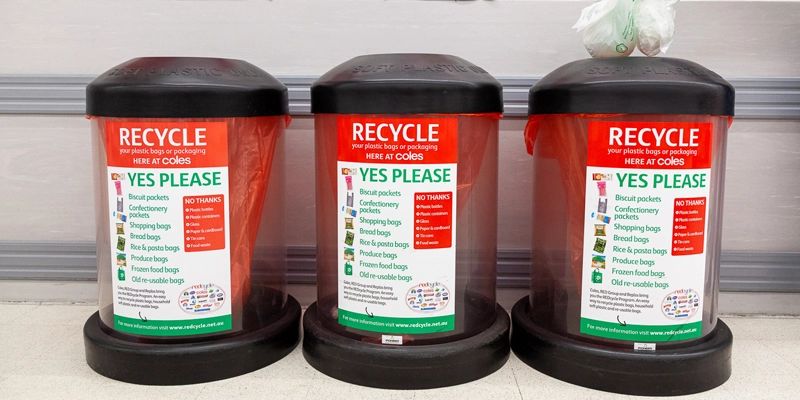
Hey, just a friendly reminder: recycling bubble wrap is not only great for reducing landfill waste, but it also helps create recycled resin for making new plastic products. But you know what's even better? Reusing bubble wrap as much as you can before recycling. It's the most environmentally friendly option.
Note: Always check with your local recycling guidelines as they may vary.
Finding local recycling facilities
- Planet Ark Recycling Near You
- Website: recyclingnearyou.com.au
- Description: A comprehensive database where you can find recycling information and centres based on your location in Australia.
- SUEZ Australia
- Website: suez.com.au
- Description: SUEZ offers a variety of recycling and waste management services, including recycling centres in various locations.
- TerraCycle
- Website: terracycle.com
- Description: TerraCycle offers national, first-of-their-kind recycling platforms allowing Australians to recycle items that were non-recyclable before.
- Cleanaway
- Website: cleanaway.com.au
- Description: Cleanaway provides waste management services including collection, disposal, and recycling. You can check their website for nearby recycling centres.
- Visy
- Website: visy.com.au
- Description: One of Australia's largest recyclers, Visy recycles paper, cardboard, glass, aluminium, and steel cans for millions of households, and is a leader in recycling education.
- Soft Plastic Recycling
- Website: redcycle.net.au
- Description: RED Group is a Melbourne-based consulting and recycling organisation. They have initiated a recovery program for post-consumer soft plastic. They have drop-off locations at many Coles and Woolworths stores.
Let's wrap it up...
So here you have it, protective bubble wrap is the perfect solution for more securely packing fragile and delicate items when moving to a different home or office. With its ability to prevent breakage or damage due to shock and vibration, bubble wrap is certainly a much-needed item for any move. Bearing in mind to select the right type of bubble wrap size for your chosen item will help keep costs down, whilst adding extra protection. Choose from a range of sizes ranging from 375mm up to 750mm so it’s easy to find the perfect fit for whatever needs protecting.
However, the most important aspect to bear in mind is its proper storage for future use and its responsible disposal once its life cycle ends. Recycling bubble wrap not only reduces landfill waste but also contributes to the production of new plastic products, favouring a circular economy. As we strive for a more sustainable lifestyle, every bit counts, and properly reusing and recycling bubble wrap is one small but significant step in that direction. So the next time you decide whether or not to use bubble wrap packing, take all this knowledge with you on your next move and always remember Find a Mover when needing to move those packaged-up items and let's do our part to be a little greener, one bubble at a time! 🌍💚
Ready to Move? Find Your Perfect Mover!
Don't let moving stress you out. Compare quotes from our network of reliable movers, read genuine reviews, and book with ease. Save time, save money, and start your move with confidence today.
- Quickly compare movers
- Read verified reviews
- Book online with confidence

